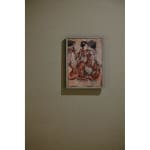Murakami Kagaku (1888–1939)
The Three Maiko
Oil on wood panel, framed
With box authentication by Nakai Sotaro (1879–1966)
31.5 x 22.5 cm
33.5 x 24.5 cm (overall)
With box authentication by Nakai Sotaro (1879–1966)
31.5 x 22.5 cm
33.5 x 24.5 cm (overall)
Further images
Exhibitions
Murakami Kagaku-Saeki Yuzo meisaku sen. Tokyo: Ginza Matsuya, 1956.Literature
Nakai Sotaro, ed. Kagaku sakuhin shu. Tokyo: Shunchokai, 1942.
After co-founding the Association for the Creation of National Painting (Kokuga Sosaku Kyokai) with others in 1918, Murakami Kagaku made several paintings of maiko (apprentice geisha), such as Maiko, Maiko Girls, Miyako Odori, and Dancing Maiko, though the work here is an extremely rare example in oil. Moreover, it comes with hakogaki (box authentication) by Nakai Sotaro, who taught the aesthetics and art history at the Kyoto Municipal Special School of Painting (Kyoto-shiritsu Kaiga Senmon Gakko) and mentored Tsuchida Bakusen, Ono Chikkyo, Sakakibara Shiho, and Murakami Kagaku as an advisor to the Association for the Creation of National Painting, increasing the art historical signicance of this gem of a piece. Compared to works painted with animal glue-based pigments, the distinctive texture created by the brushwork and force unique to oil painting, combined with the vigorous traces of the brush, make the swaying appearance of the maikos’ kimonos and obis created by dance, seem all the more sublime. By arranging the three young women together to the upper left side, Kagaku seems to have captured a single moment of movement from the stage rather than portraying posing models.
Tsuchida Bakusen, who co-founded the Association for the Creation of National Painting with Kagaku, had once considered that the difficulty in painting with traditional Japanese pigments to some extend dampened the creative urge due to its arduous process of grinding, dissolving, kneading, and heating the minerals and other materials. For Kagaku, however, the differences in feel and sensation between drawing lines with a brush on silk or paper with traditional Japanese pigments and painting on wood with oil such as the present work, perhaps inspired and moved him. The kimonos and obis of the dancing maikos exhibit the distinctive feature of oil painting, while the darkened expression of the central maiko is uniquely Kagaku in style and, regardless of material and medium, makes the viewer take pause at the rendition of the spiritual world that this artist created.
Murakami Kagaku (nihonga painter; 1888−1939)
Osaka-born nihonga painter. His real name is Takeda Shin’ichi. Graduated from Kyoto Municipal Special School of Painting. Selected to exhibit at Bunten (Ministry of Education Art Exhibition) and given the tokusen (special prize that grants entry without examination in the following year) privilege in 1916. Dissatisfied with Bunten’s idealism and founded Kokuga Sosaku Kyokai (Association for the Creation of National Painting) with Tsuchida Bakusen, Ono Chikkyo, Sakakibara Shiho, and Nonagase Banka in 1918. Moved to Ashiya and Kobe due to worsening health. Led a recluse life away from the art world ever since. Concentrated on the subjects of Buddhism and the Rokkosan mountains, his works possess a meditative and spiritual tone.
Tsuchida Bakusen, who co-founded the Association for the Creation of National Painting with Kagaku, had once considered that the difficulty in painting with traditional Japanese pigments to some extend dampened the creative urge due to its arduous process of grinding, dissolving, kneading, and heating the minerals and other materials. For Kagaku, however, the differences in feel and sensation between drawing lines with a brush on silk or paper with traditional Japanese pigments and painting on wood with oil such as the present work, perhaps inspired and moved him. The kimonos and obis of the dancing maikos exhibit the distinctive feature of oil painting, while the darkened expression of the central maiko is uniquely Kagaku in style and, regardless of material and medium, makes the viewer take pause at the rendition of the spiritual world that this artist created.
Murakami Kagaku (nihonga painter; 1888−1939)
Osaka-born nihonga painter. His real name is Takeda Shin’ichi. Graduated from Kyoto Municipal Special School of Painting. Selected to exhibit at Bunten (Ministry of Education Art Exhibition) and given the tokusen (special prize that grants entry without examination in the following year) privilege in 1916. Dissatisfied with Bunten’s idealism and founded Kokuga Sosaku Kyokai (Association for the Creation of National Painting) with Tsuchida Bakusen, Ono Chikkyo, Sakakibara Shiho, and Nonagase Banka in 1918. Moved to Ashiya and Kobe due to worsening health. Led a recluse life away from the art world ever since. Concentrated on the subjects of Buddhism and the Rokkosan mountains, his works possess a meditative and spiritual tone.







